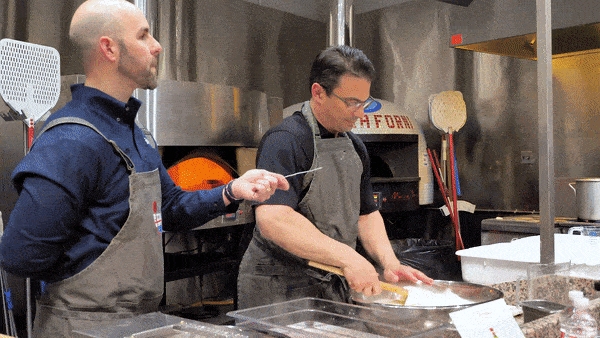3 Ways to Master Mozzarella-Making
June is National Dairy Month and we’re celebrating with mozzarella…the crowning glory of many types of pizza! The term mozzarella comes from the Italian word “mozza” which comes from the “mozzatura”, or cutting and shaping the curd. Both cow and buffalo milk mozzarella can be used in pizza-making. To make mozzarella from scratch, acid and rennet are mixed with milk. From start to finish, the entire process includes preparing the milk, coagulation, cutting, scalding, curd maturation, stretching, salting, and ripening.
Here at the Pizza University & Culinary Arts Center, we often call upon Steve Selznick and Tory Profaci from Grande Cheese, one of our partners, to demonstrate the art of making homemade mozzarella to our students. One of the aspects we appreciate most about Grande’s mozzarella cheese is that it does not contain titanium dioxide, which is often used to give cheese an unnatural, bright white color.

While some companies and pizzerias choose to purchase ready-made mozzarella, others like to make their own, adding yet another layer of freshness and authenticity to their pizzas. For this reason, Grande offers Fresh Curd which is designed to come together quickly and easily when the curd itself is heated to 135F degrees. This what you need to know to master mozzarella-making.
“The versatility of working your own curd is often overlooked. It can be formed into several shapes which chefs and operators can upsell to create more profit and differentiation. Curd can also be shaped into braids, pinwheels and rolls for additional menu applications. The pinwheels in particular can be sliced and served in appetizers and panini or chopped in salads. Burrata – which is the most popular trending cheese in the Italian fresh cheese category, can also be made from the same curd.” -Steve Selznick
“If you are taking the time to pull your own curd, it becomes a labor of love. Take your time, enjoy the process, follow the steps, and you’ll get the best results.” – Tory Profaci

1. Tempering
It’s important that the curd is covered in hot top water to bring the temperature up /this helps to eliminate it from being shocked in 175F water.
2. Heating & Compressing
Pour 4 quarts of 175F degree water into a large metal bowl, covering approximately 1” over the surface of the curd (which has previously been cut in to ¼”x1/4”x 3” strips. Allow the mixture to set for 1 minutes and 30 seconds without disturbing. Drain the water.
Firmly press the curd down and compress it into a mass at the bottom of the bowl. dissolve 6.5 ounces of salt into 3-quarts of 175F degree water. Pour salted water along the side of a large bowl, just covering the surface of the curd and allow to sit, undisturbed for 1 minute or until it reaches 135F degrees.
3.Stretching and Molding
When the curd temperature reaches 135F degrees, stretch it using a paddle. Allow it to melt and come together and fold the curd into itself until it becomes pliable. Raise the curd and hold above the mixing bowl, allowing gravity to help stretch it. Repeat the process until the entire mass of curd is smooth and uniform.
To make mozzarella balls, mold the curd into a log shape and roll the log into itself to create a ball shape at the end of the log. When the ball is he desired size, pinch it off at the base, and repeat until all curd has been molded. Place the balls into a running cold tap water bath of 60F degrees for 10 minutes. Cool the mozzarella and transfer it to a refrigerator or cooler.
Our Culinary Director, Chef Felice Colucci says “Grande makes a great product – their log and oval-shaped mozzarella stays soft and melts evenly on the pizzas without burning. They both adapt well to the Neapolitan style of pizza-making.”


